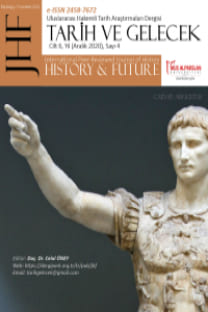Sığınma ve Savunma Yapılarının Tarihsel Gelişim Süreci: Tehlike ve Mekan
Bu araştırmanın amacı; insanlığın tarih boyunca kendilerini savunmak veya korumak amacıyla ürettikleri yapıların ve tasarımların tarihsel gelişim sürecini çok yönlü olarak derlemek ve analiz etmektir. Türlü tehlikeler, can ve mal güvenliğinin sağlanması hususunda çağlar boyunca insanları mekânsal arayışlara zorunlu kılmıştır. Mimari bilim ve sanat dalı olarak bu arayışlara yanıt verecek çözümler geliştirmiştir. Antik Çağ’dan beri yaşamın devamlılığı için tehdit olarak görülen tehlikeler ve onlara karşı koymak için geliştirilen sığınma ve savunma yapıları, azalmamış artarak çeşitlenmiştir. Malzeme ve yapı teknolojisindeki gelişmeler bu yapıların tasarımına da etki etmiştir. Sosyal, politik ve ekonomik koşullar da onları biçimlenmişlerdir. Konunun evrensel çerçevesi nedeniyle hangi savunma ve sığınma tekniğinin tam olarak ne zaman kullanıldığını saptamak mümkün değildir. Ancak araştırmalar üzerinden genel kanılara ulaşmak mümkündür. Bu araştırma kapsamında tarih çağlarında savunma ve sığınma yapıları analiz edilmeye çalışılmış, Yakın Çağ’da savaşların mimari üzerindeki etkileri irdelenmiş, Dünya’da ve Türkiye’deki güncel yaklaşımlara değinilmiştir. İnsanlık var olduğu müddetçe, tehlikeler de var olmaya devam edecektir. Bu nedenle geçmiş anlayışların ve mevcut durumun tespiti önem taşımaktadır.
Historical Development Process of Asylum and Defense Structures: Danger And Space
The purpose of this research; is to compile and analyze the historical development process of the structures and designs that humanity has produced throughout history in order to defend or protect themselves. Various dangers have compelled people to search spatially throughout the ages in order to ensure the safety of life and property. As a branch of architectural science and art, it has developed solutions to respond to these quests. The dangers that have been seen as a threat to the continuity of life since ancient times and the shelter and defense structures developed to counter them have not decreased but increasingly diversified. Developments in materials and building technology have also affected the design of these structures. Social, political and economic conditions have also shaped them. Due to the universal framework of the subject, it is not possible to determine exactly which defense and sanctuary technique was used and when. However, it is possible to reach general conclusions through research. Within the scope of this research, defense and shelter structures in the historical ages are tried to be analyzed, the effects of wars on architecture in the Modern Age are examined, and current approaches in the world and in Turkey are mentioned. As long as humanity exists, risks will continue to exist. For this reason, it is important to determine the past understandings and the current situation.
___
- Ağırman, F. (2018). Hobbes ve Rousseau’nun Devlet Kuramlarında Doğa Durumu. Pamukkale Üniversitesi Sosyal Bilimler Enstitüsü Dergisi, (32), 115-120.
- Aktan, G. (2018). Çatalhöyük’te Çıkarılan Boğa Boynuzlarını Anlamlandırmada Antik Dönem Mitolojilerindeki Boğa Figürü. İdil Sanat ve Dil Dergisi, 7(50), 1221-1228.
- Betti, M., Orlando, M., & Vignoli, A. (2011). Static behaviour of an Italian Medieval Castle: Damage assessment by numerical modelling. Computers & Structures, 89(21-22), 1956-1970.
- Buyruk, H. (2013). Ovalık Kilikya’da Bir Bizans Sınır Savunma Yapısı: Lamas Kalesi. Journal Of International Social Research, 6(25).
- Cantor, L. M. (1978). The medieval castles of Leicestershire. Leicestershire Archaeological
- Carr, E. H. (2015). Yirmi Yıl Krizi 1919-1939, İstanbul Bilgi Üniversitesi Yayınları
- Clausewitz. C.V. (2018). Savaş Üzerine, Alfa Yayınları.
- Crone, B. A. (1994). Crannogs and chronologies. In Proceedings of the Society of Antiquaries of Scotland (Vol. 123, pp. 245-254).
- Erdinç, J. E., & Kariptaş, F. S. Bildiri: Kapadokya; Toprak ve Doğaya Uyumlu Yaşam Modeli. İç ve Dış Arasındaki Çeper Temalı Ulusal Mekân Tasarımı Sempozyumu 2016 Bildiri Kitabı
- Fredengren, C. (2002). Crannogs: a study of people’s interactions with lakes, with particular reference to Lough Gara. Bray. Wordwell.
- Heywood, A. (2011). Küresel Siyaset, Adres Yayınları.
- Hobbes, T. (2018). Leviathan, Gece Kitaplığı.
- Kıyak, L., & Özcan, U. (2022). Yeraltı Şehirlerinde Sürdürebilirlik. Sosyal Ve Beşerî Bilimlerde Güncel Araştırmalar-I. Kilimnik, E. V., & Kholodova, L. P. (2014). The Medieval Castle as a Symbol of Military-Political, Economic and Legal Power in the European Regions of the 10th-17th Centuries. Terra Sebus: Acta Musei Sabesiensis, Special Issue. 459
- Kocalar, A. C. (2018). Arkeolojik Yeralti Yerleşmeleri ve Koruma Sorunlari: Nevşehir Yeralti Şehirleri (Derinkuyu, Kaymakli). Journal of Awareness (JoA), 3(3), 25-46.
- Okuyucu, D. (2007). Derinkuyu Yeraltı Şehri. Atatürk Üniversitesi Sosyal Bilimler Enstitüsü Sanat Tarihi Ana Bilim Dalı Yüksek Lisans Tezi
- Oram, R. D. (2008). Royal and Lordly Residence in Scotland c 1050 to c 1250: An Historiographical Review And Critical Revision. The Antiquaries Journal, 88, 165-189.
- Özyıldırım, M., & Yeğin, Y. (2021). Olba’da Hıristiyanlığın İlk İbadethanesi: “Mağara–Kilise”. Seleucia, (XI), 175-186. Rodríguez Jaume, M. J. (2019). “New racism” from the perspective of “Quiet migration”: Interracial adoption in Spain. Migraciones internacionales, 10.
- Russell B. (1994). İktidar, Cem Yayınevi.
- Sarı, Y. (2006). Hendek Savaşı. Sakarya Üniversitesi Sosyal Bilimler Enstitüsü, İslam Tarihi ve Sanatları Ana Bilim Dalı Yüksek Lisans Tezi
- Vitrivius (2021). Mimarlık Üzerine On Kitap, Şevki Vanlı Mimarlık Vakfı Yayınları
- Waltz (2009). İnsan Devlet ve Savaş Teorik Bir Analiz, Asil Yayın Dağıtım
- Yayın Aralığı: Yılda 4 Sayı
- Başlangıç: 2015
- Yayıncı: Celal ÖNEY
Sayıdaki Diğer Makaleler
Talât Paşa Suikastının Amerikan Basınındaki Yansımaları
İmparator I. Manuel Komnenos’un Balkan Politikası
Damastion kentinin Orta Dardanya topraklarındaki izleri
Berlin Sefiri İbrahim Hakkı Paşa’nın I. Dünya Savaşı Hakkında Bilinmeyen İki Raporu (1916)
Eski Van Şehri ve Tarihi (1915’e Kadar)
Bir Devlet Adamı Olarak Hasan Tahsin Banguoğlu Hayatı Üzerine Bir Çalışma
Cumhuriyet Halk Partisi İktidarı Döneminde Büyük Doğu’nun Türk İnkılabına Bakışı (1943-1950)
Sancılı Yıllar: Yerel Basına Göre İkinci Dünya Savaşı’nın Muğla’ya Yansıması
Demokrat Parti Döneminde 30 Ağustos Zafer Bayramı Algısı (1950 - 1960)
